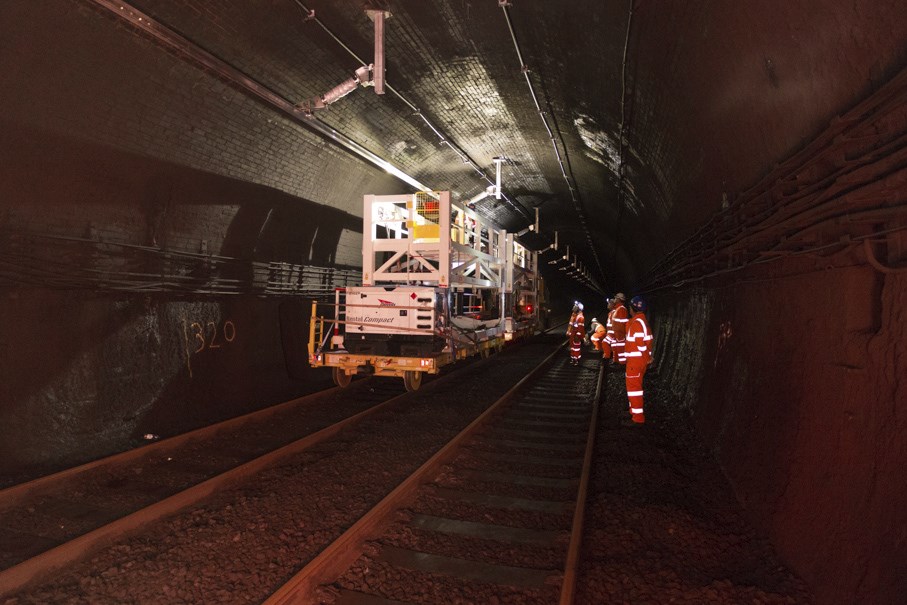Sunday 23 Oct 2016
Electrification milestone reached as Severn Tunnel re-opens to rail passengers following upgrade
- Region & Route:
- | Wales & Western: Western
- | Wales & Western
The Severn Tunnel reopened to rail passengers yesterday (Saturday, 22 October) following the completion of six weeks of upgrade work to prepare the railway line for electrification, which will result in more seats and faster, more reliable journeys for passengers.
The route has been closed since 12 September as Network Rail’s orange army carried out extensive work to prepare the tunnel for the arrival of a new fleet of bigger, faster and greener electric trains.
In preparation for the closure, 40 tonnes of soot were removed from the tunnel along with four miles of cable.
During the six-week closure, more than eight miles of conductor rail, which will power a new fleet of electric trains through the 130-year-old tunnel, was installed, whilst work also took place in the neighbouring Patchway Tunnels in south Gloucestershire.
To accommodate the electrification equipment, the track was lowered in the Patchway Tunnels and underneath the nearby Little Stoke Farm bridge to preserve its historical architecture.
The work formed an important part of Network Rail’s Railway Upgrade Plan to provide a bigger, better, more reliable railway for passengers. It follows projects already under way across the West Country and Thames Valley to electrify the Great Western Main Line.
Mark Langman, Network Rail’s Western route managing director, said: “We are delighted to have delivered this vital milestone in the project to electrify the Great Western Mainline as part of our Railway Upgrade Plan to give passengers a bigger and better railway.
“We would like to thank passengers for their patience over the last six weeks as we completed this essential upgrade.”
Dan Tipper, project director at Network Rail, said: “It has been a phenomenal team effort, involving over 250 engineers and close working with our principal contractors ABC Electrification and Babcock as well as numerous suppliers, designers and sub-contractors including Amco, Keltbray and Arup, to deliver this essential stage of the electrification project.
“I would like to thank every single member of the team that has worked on this iconic project for their hard work and dedication to deliver this upgrade successfully and on time.”
John Skentelbery, tunnels operations director for ABC Electrification said: “This part of the electrification scheme was a huge challenge and we have all worked extremely hard to complete the work safely and on time. I am very proud of this team and what we have achieved in the last six weeks.”
ENDS
Notes to Editors:
Seven Severn Tunnel facts:
- Engineers worked day and night in the tunnel with 18,000 person-days worked during the six week closure
- More than 20 conductor rail anchors and 240 metres of conductor rail were installed in the Severn Tunnel per ten hour shift
- 7,000 anchors were installed to support the new electric equipment
- 14kms of overhead conductor rail installed and supported by 1648 drop tubes that are suspended from the tunnel crown
- Over 3,500 people-hours of preparatory work was completed ahead of the six week upgrade project
- Over 40 tonnes of soot was removed from the tunnel during the preparatory work carried out prior to the six week project
- The Severn Tunnel is 4 miles long, with water sitting on top of a 2.25 mile stretch
The main base for the six-week Severn Tunnel upgrade project was at a large site compound established at Filton Airfield.
Filton Compound Statistics:
- Filton is a 4.5 hectare site situated on the historic Filton runway in south Gloucestershire
- Providing Network Rail’s ‘orange army’ with minibus transport from the compound to work sites saved over 500,000 miles and 260 tonnes of CO2 during the six week project
- The compound was run on 70% renewable energy; 117 solar panels and 10 wind turbines and as a result it has saved 160 tonnes of CO2
Contact information
Passengers / community members
Network Rail national helpline
03457 11 41 41
Latest travel advice
Please visit National Rail Enquiries
Journalists
Network Rail press office -Western route
MediaRelationsWestern@networkrail.co.uk
About Network Rail
We own, operate and develop Britain's railway infrastructure; that's 20,000 miles of track, 30,000 bridges, tunnels and viaducts and the thousands of signals, level crossings and stations. We run 20 of the UK's largest stations while all the others, over 2,500, are run by the country's train operating companies.
Usually, there are almost five million journeys made in the UK and over 600 freight trains run on the network. People depend on Britain's railway for their daily commute, to visit friends and loved ones and to get them home safe every day. Our role is to deliver a safe and reliable railway, so we carefully manage and deliver thousands of projects every year that form part of the multi-billion pound Railway Upgrade Plan, to grow and expand the nation's railway network to respond to the tremendous growth and demand the railway has experienced - a doubling of passenger journeys over the past 20 years.
Follow us on Twitter: @networkrail
Visit our online newsroom: www.networkrailmediacentre.co.uk

